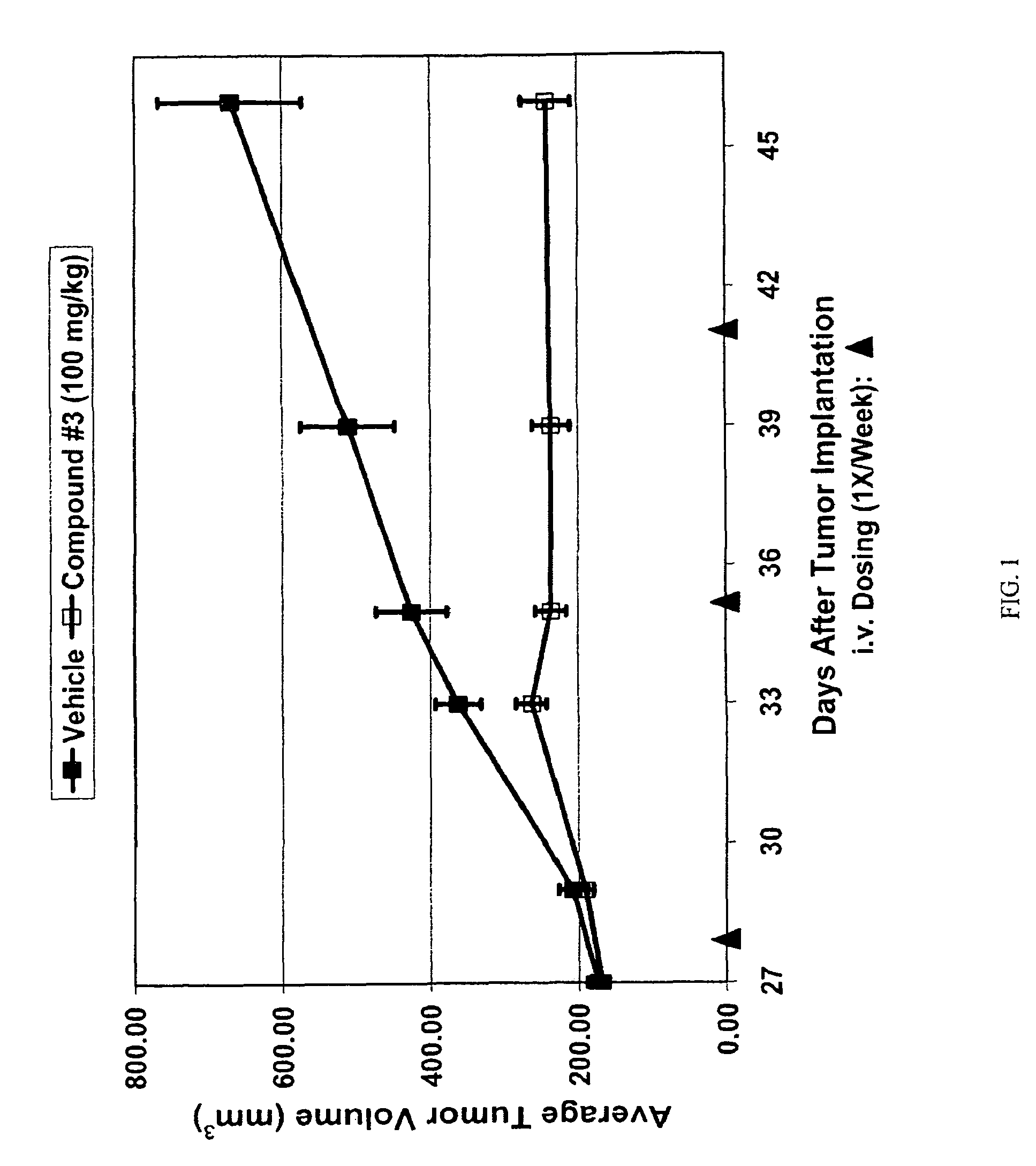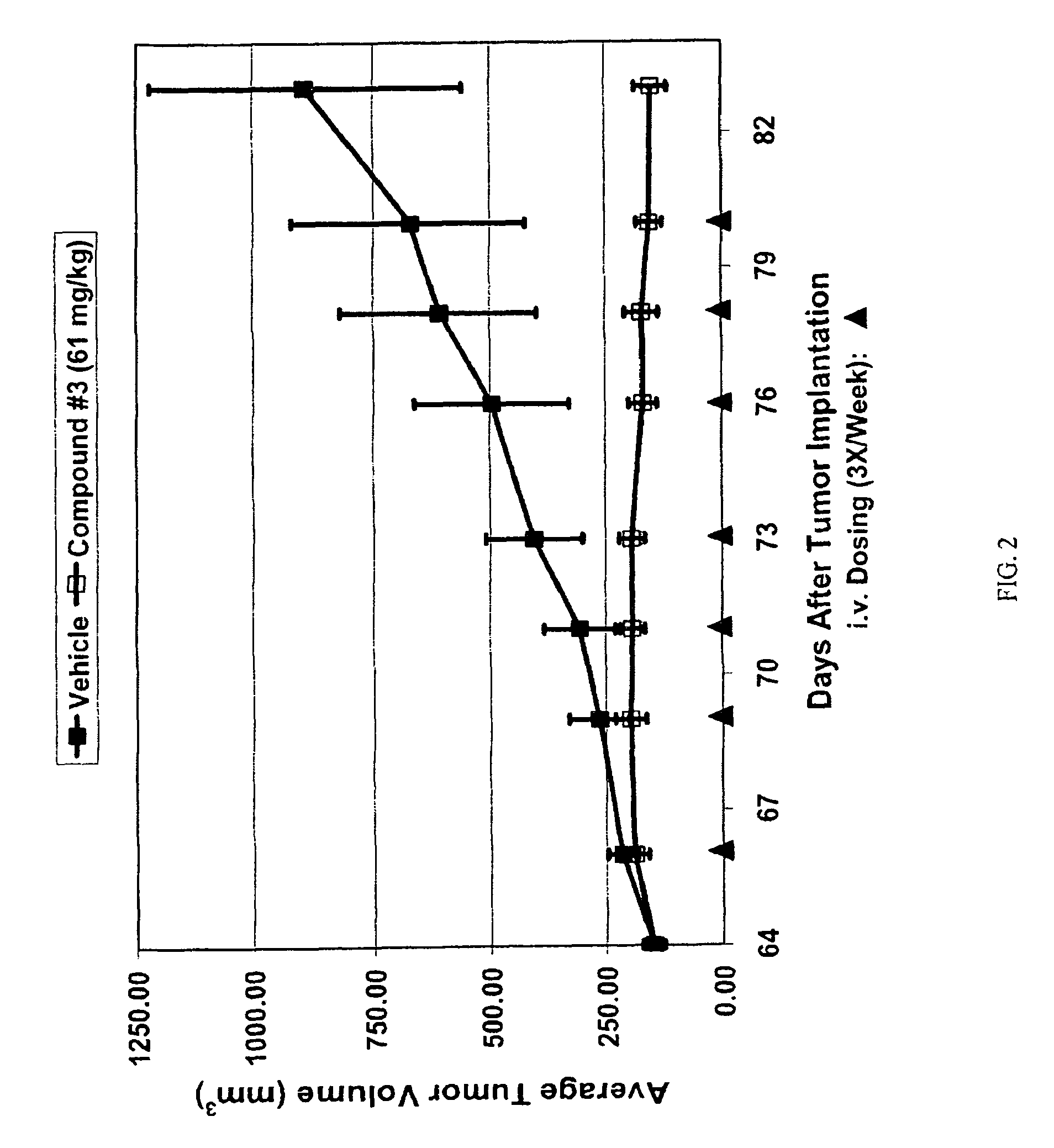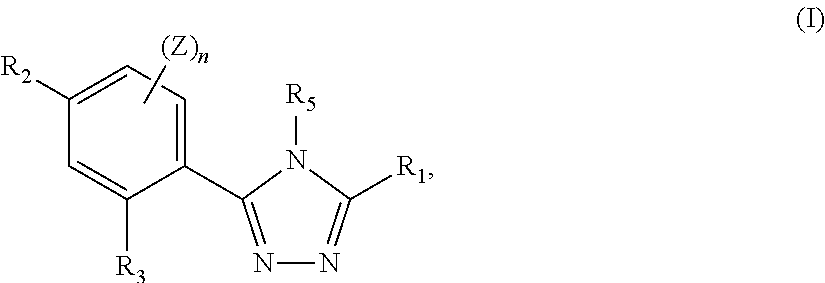Triazole compounds that modulate HSP90 activity
a technology of hsp90 activity and triazole, which is applied in the field of triazole compounds that modulate hsp90 activity, can solve the problems of unsatisfactory current chemotherapy, unfavorable treatment effect of cancer patients, and inability to fully implement a therapeutic agent that acts on one molecular targ
- Summary
- Abstract
- Description
- Claims
- Application Information
AI Technical Summary
Benefits of technology
Problems solved by technology
Method used
Image
Examples
example 1
4-(4-(2,3-dihydro-1H-inden-5-yl)-5-oxo-4,5-dihydro-1H-1,2,4-triazol-3-yl)-5-hydroxy-2-isopropylphenyl dihydrogen phosphate (Compound 1)
[0465]
[0466]The synthesis consists of 5 steps. The following is the procedure:
Synthesis of the thioamide N-(2,3-dihydro-1H-inden-5-yl)-2,4-dihydroxy-5-isopropylbenzothioamide 3
[0467]To a stirred suspension of 0.50 g (3.28 mmols) of 4-isopropyl resorcinol in 5 mL of BF3.2AcOH at 5° C. was added drop wise 0.57 g (3.28 mmols) of 5-isothiocyanato-2,3-dihydro-1H-indene 2. The mixture was stirred at 5° C. for 15 min. and cooling bath removed. The mixture was then stirred at room temperature for 1.5 h, poured into 100 mL of cold water while stirring. The yellow solid obtained was filtered, dried, redissolved in ethylacetate and dried over Na2SO4. Concentration followed by column chromatography afforded 0.70 g of the product 3 as yellow solid.
Synthesis of 3-(2,3-dihydro-1H-inden-5-yl)-7-hydroxy-6-isopropyl-4-thioxo-3,4-dihydro-2H-benzo[e][1,3]oxazin-2-one 5
[...
example 2
5-hydroxy-4-(5-hydroxy-4-(6-morpholinopyridin-3-yl)-4H-1,2,4-triazol-3-yl)-2-isopropylphenyl dihydrogen phosphate (Compound 2)
[0474]
[0475]6-morpholinopyridin-3-amine (3.59 g, 20 mmol) in 50 ml CH2Cl2 was added to the solution N,N′-carbonyldiimidazole (CDI) (4.0 g, 25 mmol) in 100 ml CH2Cl2, and the solution was mix at RT for 1 h. Solvent were removed on rotary evaporator and the residue was dissolved in 50 ml dioxane and treated with hydrazine (6.5 ml, 200 mmol, 10 eq) at RT to 45° C. for 1 h. The reaction mixture was subjected to EtOAc / aqueous workup to remove excess hydrazine The aqueous solution was extracted with CH2Cl2 The organic layer was dried over Na2SO4, filtered evaporated in vacuo gave N-(6-morpholinopyridin-3-yl)hydrazinecarboxamide (1) (3.32 g, 70%) as a light brown solid. To a stirred solution of 1.90 g (6.0 mmol) of the 2-(benzyloxy)-5-isopropyl-4-(methoxymethoxy)benzaldehyde (2) in 40 ml of methanol was added 1.43 g (6.0 mmol) of the hydrazide (1) and acetic acid (3...
example 3
5-hydroxy-2-isopropyl-4-(4-(1-methyl-1H-indol-5-yl)-5-oxo-4,5-dihydro-1H-1,2,4-triazol-3-yl)phenyl dihydrogen phosphate (Compound 3)
[0482]
(E)-2-(2-(benzyloxy)-4-(ethoxymethoxy)-5-isopropylbenzylidene)-N-(1-methyl-1H-indol-5-yl)hydrazinecarboxamide
[0483]To a suspension of the aldehyde in ethanol was added AcOH and stirred. To the resultant mixture was added of N-(1-methyl-1H-indol-5-yl)hydrazinecarboxamide portion wise at room temperature and the resultant mixture was heated at 80° C. for 1 h. The mixture was cooled to RT and filtered the precipitate, washed with ethanol and ether and dried. Vacuum drying afforded the product.
[0484]
3-(2-(benzyloxy)-4-(ethoxymethoxy)-5-isopropylphenyl)-4-(1-methyl-1H-indol-5-yl)-1H-1,2,4-triazol-5(4H)-one
[0485]To a stirred suspension of (E)-2-(2-(benzyloxy)-4-(ethoxymethoxy)-5-isopropylbenzylidene)-N-(1-methyl-1H-indol-5-yl)hydrazinecarboxamide in ethanol was added NaOH and stirred. To the resultant mixture, was added K3Fe(CN)6 at once and the resulta...
PUM
| Property | Measurement | Unit |
|---|---|---|
| weight percent | aaaaa | aaaaa |
| weight percent | aaaaa | aaaaa |
| weight percent | aaaaa | aaaaa |
Abstract
Description
Claims
Application Information
 Login to View More
Login to View More - R&D
- Intellectual Property
- Life Sciences
- Materials
- Tech Scout
- Unparalleled Data Quality
- Higher Quality Content
- 60% Fewer Hallucinations
Browse by: Latest US Patents, China's latest patents, Technical Efficacy Thesaurus, Application Domain, Technology Topic, Popular Technical Reports.
© 2025 PatSnap. All rights reserved.Legal|Privacy policy|Modern Slavery Act Transparency Statement|Sitemap|About US| Contact US: help@patsnap.com



